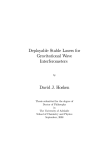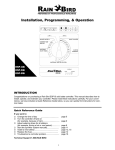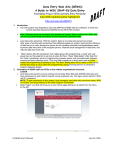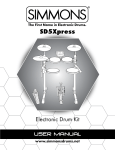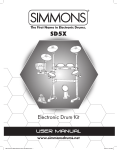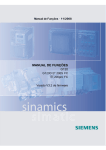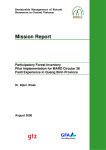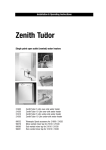Download turbotrack card tunings - Lighting Systems Design, Inc.
Transcript
ATTENTION! ATTENTION! All TurboTrack2 enclosures now wired to ILDA Standard wiring specifications. 01/01/2000 T2 TurboTrack versions 2.0 and 2.0b Maximum Performance Servo Amplifier for Galvanometer Scanners Lighting Systems Design, Inc. 4625 Winter Garden Road, Suite A-2 Orlando, Florida 32811-1777 U.S.A. Phone 407-299-9504 • Fax 407-299-3965 www.lsdi.com Page 1 Rev 10/10/01 Pagepage This 2 Rev intentionally 10/10/01 left blank. TURBOTRACK2 SCANNER DRIVER AMPLIFIER INTRODUCTION The TurboTrack2 (T2) is a dual-channel servo amplifier designed for use with optical scanners. In the laser display industry, the most commonly used models of scanner are the G 120D (or DT) from General Scanning and the 6800 series scanner from Cambridge Technology. T2 is a two-layer printed circuit board measuring 9 inches by 9 inches. Large heat sink fins are attached to each side of the card, increasing the board's footprint to 9.5 inches wide by 9 inches in length by 2.5 inches in height. Fan-cooling of this card will greatly increase its performance characteristics as well as prevent overheating of some power components. The following features summarize the most important design benefits of the TurboTrack2 scanner driver amplifier: > > > > > > > > > > > > > Angle Intelligence -H-bridge drive -High K low-frequency damping for the CTI 6800 series scanners Input signal limiting Position and velocity outputs A(utomatic) G(ain) C(ontrol) for position transducer Output current limiting Dual controls for high speed/low speed operation Differential inputs Input polarity switching Signal pre-emphasis Position scale and balance for CTI 6800 series scanners DC offset bi-color LED indicators Most important for the laser display user is TurboTrack2’s stable performance at high speeds. Extensive testing has shown that the ILDA test pattern can easily be scanned at 24,000 vectors per second at a scan angle of 20 degrees optical, using G120D scanners. INPUT CONNECTOR The input to TurboTrack2 is a DB 15 male connector. Differential inputs are recommenced. If single-ended (or unbalanced) inputs are used, both negative inputs should be tied to signal ground. Simultaneous position, velocity, and drive current signals are also available from the input connector. OUTPUT CONNECTOR The output connectors are both DB- 15 female. These are directly compatible with General Scanning G120D scanners. Cambridge Technology's scanner cable design requires a modification to replace the DB-9 connector with a DB- l 5 male connector. Page 3 Rev 10/10/01 Whereas the General Scanning G120D scanners are driven with the H-bridge, the 6800 series scanners achieve more stable performance with single-ended drive. Galvo low is therefore tied to ground for operation with the 6800 series scanners (see diagram, page 15). DB-9 to DB- l 5 adapters are not recommended. Scanner cables can be up to l 0 feet without any visible diminishing of scanner performance. POWER SUPPLY The TurboTrack2 requires a bipolar supply of +/-20 Volts DC as a minimum, and +/- 28 Volts DC as a maximum. LSDI recommends a minimum continuous current rating of 3 Amperes. When running CTI 6800 series scanners, a higher current capacity is desirable. Best performance comes with the use of a regulated power supply; however, a "raw" DC supply (transformer, full-wave bridge rectifiers and filter capacitors) will also work well. Switch mode supplies can also be used. COOLING The power output stage of the TurboTrack2 uses the LM12CLK from National Semiconductor. This is a power operational amplifier that can dissipate 150 watts of power. For this reason, it is highly recommended that the TurboTrack2 be fan-cooled wherever possible. The large heat sinks are constructed of industry-standard Aavid heat sink material, but some air flow is essential for reliable operation. This is particularly important when the amplifier is mounted in a chassis or rack-mount enclosure. TurboTrack2 Adjustments The TurboTrack2 is a 2-channel card. It also gives the user the ability to have 2 different tunings on each card, an "A" tuning and a "B" tuning. In practice, this lets the user set one tuning for l type of scanner and the second tuning for another type of scanner, or set both tunings for the same scanners but different speeds, i.e. 12,000 points per second and 24,000 points per second. There are several useful combinations available. No matter the scanner models or designated use for each tuning, the adjustments are the same for each axis. The primary adjustments are as follows: > > > > > position offset input gain servo gain damping high damping These adjustments are made via 15-turn trimmer potentiometers located at one end of the T2 card. There are two sets of potentiometers for each axis, representing the "A" tuning and the "B" tuning capability of the circuit. Page 4 Rev 10/10/01 From the outside of the card inward, the order of adjustments is as follows: position offset, input gain, servo gain, damping and high damping. The trimmer potentiometers are separated in the middle by a toggle-type DIP switch (GrayhIll p/n 76STD02). This is the scan polarity inversion switch. Use this switch to change the left/ right, up/down orientation of the laser graphic image. Other adjustments available to the user are DIP switches located above and perpendicular to the trimmer potentiometers. These ganged DIP switches (Grayhill p/n 78B04) can be selected to use either General Scanning or Cambridge Technology scanners, as well as select the "A" or "B" tuning. These controls can only be accessed from the top of the card. There are two additional "top" adjust trimmer potentiometers on the T2, both for use with the CT16800 series scanners. One is Position Scale, and the second is Position Balance. These are set at the factory and should not require further adjustment. Before performing any adjustments, verify that ail supplemental components are operating normally, i.e. power supply, scanner connections, or input signal to the scanner amplifier. Adjustment Procedure: General Scanning > > > > > > > > > > > > > > > Scan a square wave test pattern at a vector speed of 9 to l 0 kilohertz. Make sure ail trimpots are fully counter-clockwise, except the position offset. Center the position offset. Connect an oscilloscope or a digital voltmeter (DVM) to the position outputs. Remove the fuses. Apply power to the amplifier. Adjust the position offset for 0 volts, each axis. Turn off power to the amplifier and replace the fuses in the fuse clips. Re-apply power to the amplifier. Turn input gain eight turns clockwise. Slowly adjust servo gain until scanner begins to operate. Adjust damping to correct overshoot. Use only normal damping; do not use high frequency damping, as damage to the scanners or the board may occur. Increase input gain until laser image is about 1/2 size. Adjust servo gain to increase speed, then compensate with damping. Once the system is optimized, increase input gain for full size. The AURA Technologies' test pattern is recommended. If the interior circle begins to distort, maximum gain has been reached. Reduce gain to point just before distortion occurs. Set input polarity toggle DIP switch for correct image orientation. Page 5 Rev 10/10/01 ? NOTE: Servo gain control on T2 is a true servo gain. With this control turned down (counter-clockwise) no scanning will occur. If you are trouble-shooting a "no scanning problem" and you have verified a good signal going to your scanners, be sure to check the servo gain adjustment. Adjustment Procedure: Cambridge Technology As the Cambridge Technology's 6800 series scanners (6800H and 6800HP) do not have a torsion rod or other center return mechanism, the scanners may be directing the beam to most any direction when not energized. When beginning the calibration procedure, the scanner will suddenly move to the approximate center when the servo gain is sufficient to drive the scanner. The oscilloscope/digital voltmeter centering procedure may be done with the scanners disconnected from the board. > Scan a square wave test pattern at a vector speed of 9-10 kHz. > Make sure ail trimpots are fully counter-clockwise, except the position offset, which should > > > > > > > > > be approximately centered. Power up the amplifier. Turn input gain eight turns clockwise. Slowly adjust servo gain until scanner begins to operate. Adjust damping to correct overshoot. Normal damping affects large changes. Hi damping is used to correct small errors, in conjunction with the normal damping. Hi damping corrects errors of high spatial frequency. Increase input gain until image is about 1/2 size. Repeat steps 1-4 for the opposing axis. Adjust servo gain to increase speed, compensate with damping. Use both Hi and normal damping to optimize velocity profile. Once the system is optimized, increase input gain for full size. The ILDA or Auratech test pattern is recommended. If the interior circle begins to distort, maximum size has been reached. Reduce gain to the point just before distortion occurs. Set input polarity for the correct orientation. Adjustment Procedure: Mode Selection There are several DIP switches accessible from the top of the TurboTrack board. These should only be switched with the power OFF. This is very important, as damage to the board or the scanners may result otherwise. These switches are shown on a diagram accompanying this manual. Page 6 Rev 10/10/01 There are four (4) ganged DIP switches at the front of the TurboTrack card for selection of different amplifier tunings. On each side, only one switch bank should be in the "ON" position. Looking at the card from an end-on view, "ON" is away from the user, "OFF is toward the user. The outside bank "A" affects the outside four adjustment potentiometers: input size, servo gain, normal damping and high frequency damping. The position offset controls at the outer edge of the card are not affected. The inner bank of controls accessed by the "B" switch are identical to the "A" controls. The dual adjustments allow for many possibilities, for example > High speed scanning versus lower speed scanning > General Scanning versus Cambridge Technology > Main scanner set and spare scanner set In the center of the TurboTrack are four more ganged DIP switches. These are the primary controls to switch from GS Operation to CT operation. Ail switches to the outside of the card is General Scanning mode; ail switches to the center of the card is Cambridge Technology mode. (Please see the TurboTrack2 configuration diagram in this manual.) Closes to the fuses are two (2) quad DIP switches. SW # 181, 182, 381 and 382 are used to add pre-emphasis to the command signal. This increases the effective bandwidth of the scanners by as much as 6 kHz. For example, if the scanners are tuned for 24K points per second operation, switching on pre-emphasis will allow them to run images digitized to run at 30K. SW# SB and SC are on for ail modes of operation. SW # 222 and 422 are off for GS Mode and on for CT mode. This is output stage compensation for the 6800H and 6800HP scanners. Page 7 Rev 10/10/01 Connector pinouts on T2 stand-alone card INPUT CONNECTOR (D Sub Miniature 15 pin male) OUTPUT CONNECTOR (D Sub Miniature 15 pin female) Pin Number Pin Number 1 X axis positive 1 Galvo High 2 X axis negative 2 Galvo Low 3 X position output signal 3 Position plus 4 X velocity output signal 4 Position ground 5 Y velocity output signal 5 Heater ground 6 Y position output signal 6 - 15 VDC 7 Y axis negative 7 Heater drive 8 Y axis positive 8 GSI (General Scanning) AGC out 9 X axis ground 9 Galvo High 10 X axis ground 10 Galvo Low 11 X axis current output signal 11 Position minis 12 Not connected 12 GSI (General Scanning) AGC in 13 Y axis current output signal 13 Scanner ground 14 Y axis ground 14 Cambridge Technology AGC out 15 Y axis ground 15 Thermal in Page 8 Rev 10/10/01 Page 9 Rev 10/10/01 100K 4. HIGH DAMPING 3 20K 2 3. DAMPING LEFT 1 20K 4 2. SERVO GAIN 3 “B” tuning 20K 2 “A” tuning 1. INPUT GAIN 1 Position offset Scanner tuning DIP switches 4 DB15 Male (Input) Connector POLARITY SWITCH 2 4 RIGHT 1 3 2 1 Bi-color LED’s These LED’s are on during calibration and during normal operation of the amp. The LED indicates that current is going through the scanner. 3 “A” tuning Position offset Lighting Systems Design, Inc. 4625 Winter Garden Road, Suite A-2 Orlando, Florida 32811-1777 U.S.A. Phone 407-299-9504 • Fax 407-299-3965 www.lsdi.com 4 “B” tuning Scanner tuning DIP switches TURBOTRACK2 Trim Pot Adjustments Expanded View OUTPUT Power terminal block OUTPUT 12 LM GSI Mode 12 LM CT Mode 2 AMP FUSES GSI Mode Pre-emphasis OFF A TRIM POTENTIOMETERS B Scanner tuning DIP switches GSI Mode Pre-emphasis ON INPUT POLARITY SWITCH CT Mode Pre-emphasis OFF GSI Mode B Scanner tuning DIP switches A TRIM POTENTIOMETERS TURBOTRACK2 CONFIGURATION MAIN ELEMENTS REV. 1999/07/10 KEY: Power output stage LM12CLK Output connectors DB-15 female Input connector DB-15 male Fuses 3AG type Fastblo GSI General Scanning (GSI Luminonics) CT Cambridge Technology WARNING!! Before changing any scanner settings or tunings on T2 card, turn power to the card OFF! You risk damage to T2 card or scanners if power is not turned off before changing settings.** **Pre-emphasis can be turned on or off when card is powered up. Rev 10/10/01 Page 10 HEAT SINK HEAT SINK Page 11 Rev 10/10/01 2 3 4 2 3 4 THIS IS A DETAIL VIEW OF THE 4-POSITION DIP SWITCH THAT HAS BEEN “GANGED”. ALL 4 SWITCHES ARE JOINED TOGETHER VIA A BAR PLACED ACROSS THE TOP OF THE SWITCH. O N 1 PLEASE NOTE THE DIRECTION OF THE DIP SW ITCH FOR THE “ON” POSITION. THE SWITCH MUST BE PUSHED TOWARD THE NUMERICAL INDICATOR (THE DIRECTION OF THE ARROW) TO BE IN THE “ON” POSITION. THIS IS A DETAIL VIEW OF THE GRAYHILL 4-POSITION DIP SWITCH USED ON THE TURBOTRACK CARD. O N 1 O N O N 1 1 2 2 3 3 4 4 O N O N 1 1 TURBOTRACK CARD TUNINGS 3 3 4 4 THIS IS “B” TUNING. DB15 INPUT CONNECTOR O N O N 1 1 2 2 3 3 4 4 THIS IS “A” TUNING. NOTE DIRECTION OF “ON” ARROW. 2 2 DB15 INPUT CONNECTOR O N O N 1 1 2 2 3 3 4 4 Rev 10/10/01 Page 12 4 S L 3 D 2 O N I 4 3 2 1 4 3 1 1 2 4 O N O N 3 O N O N 4 (THIS DRAWING NOT TO SCALE) 4 O N 4 2 3 4 Page 13 3 2 O N O N with pre-emphasis OFF 3 CAMBRIDGE TECHNOLOGY MODE 2 with pre-emphasis OFF 1 1 1 GENERAL SCANNING MODE 4 3 2 S 3 L 2 2 D 1 1 1 I 4 3 2 1 4 4 3 3 2 2 O N 1 1 O N O N TURBOTRACK CARD TUNINGS O N Rev 10/10/01 Front of enclosure Bridge rectifier Fuse AC indicator light Fan T2 Card Fan Back of enclosure Heat Sink TURBOTRACK2 Enclosure Top View Card is fused with a 2 Ampere “fast blo” fuse. DC power switch can turn DC power on and off to card; AC indicator lights shows that AC power is on; Notes: DC power switch Capacitors Transformer Power Entry Module Lighting Systems Design, Inc. 4625 Winter Garden Road, Suite A-2 Orlando, Florida 32811-1777 U.S.A. Phone 407-299-9504 • Fax 407-299-3965 www.lsdi.com Rev 10/10/01 Page 14 Heat Sink N/A N/A N/A 2 4 7 N/A N/A N/A 7 8 9 10 N/A 2 conductor cable with shield/drain 24 gauge 4 conductor cable with shield/drain 24 -28 gauge All pins gold flash Shield/drain from 2 conductor cable should isolated from shield/drain from 4 conductor cable 5. Use heatshrink tubing every 12” to secure 2 conductor and 4 conductor wires to each other along 10 feet 6. D-Sub 15 pin connector to have back shell 1. 2. 3. 4. 15 N/A Rev 10/10/01 Lighting Systems Design, Inc. Orlando, Florida 2 3 4 5 CAGE CODE SHEET CT-010731 John Robert Birchman DWG NO Cambridge 6800 Scanner Cable For Turbo Track Amplifier None A SCALE SIZE TITLE P2 P1 1 of 1 CAM68T Scanner Cable Insertion (back) view 1 N/A 6 12 N/A 10 N/A 2 6 Motor - 6 BLK Galvo High 1 7 Motor + 5 RED 13 Scanner Gnd Heater Gnd 8 Shield #1 8 5 9 AGC Out 3 GRN 14 CTI AGC Out 4 10 Diode Common Position + 3 lb la WHT 9 Position Gnd P2 1 RED BLK P1 AMP 102387-1 10 Feet Scanner Side Amplifier Side D-Sub 15 pin male 11 Position - Notes: Page 15 A REV Amplifier Side D-Sub 15 pin male 10 Feet Scanner Side D-Sub 15 pin female 8 3 GSI AGC out Position + P2 Position + BLK P1 3 GSI AGC out RED 8 Position Gnd 11 Position - 4 Galvo High WHT 1 Galvo Low 11 Position - Position Gnd RED 2 12 GSI AGC in 4 Galvo High BLK GRN 1 Galvo Low 12 GSI AGC in 2 N/A 5 9 N/A N/A Galvo High 13 Scanner Gnd 9 N/A 6 N/A 13 Scanner Gnd 5 N/A 7 10 Galvo Low 6 N/A 10 N/A 7 14 N/A None P1 P2 G120 Scanner Cable CAGE CODE SHEET GS-010731 John Robert Birchman DWG NO General Scanning G120 Scanner Cable For Turbo Track Amplifier 14 N/A TITLE SIZE SCALE A 15 N/A Orlando, Florida Lighting Systems Design, Inc. 15 N/A Notes: 1. 2 conductor cable with shield/drain 24 gauge 2. 4 conductor cable with shield/drain 24 -28 gauge 3. All pins gold flash 4. Shield/drain from 2 conductor cable should isolated from shield/drain from 4 conductor cable 5. Use heatshrink tubing every 12” to secure 2 conductor and 4 conductor wires to each other along 10 feet 6. D-Sub 15 pin connectors to have back shell 1 of 1 Rev 10/10/01 A REV Page 16 ILDA compatible input connector pinouts on T2 rack-mount unit T2 Box (Computer DB25M) Pin number Signal name ILDA T2 Signal 1 X+ X+ 2 Y+ Y+ 3 Intensity + Not Used 4 Interlock A Interlock A 5 Red + Red + 6 Green + Green + 7 Blue + Blue + 8 Deep Blue + Deep Blue + 9 Yellow + Yellow + 10 Cyan + Cyan + 11 Z+ Not connected 12 Not connected Not connected 13 Shutter Shutter 14 X- X- 15 Y- Y- 16 Intensity - Not Used 17 Interlock B Interlock B 18 Red - Red - 19 Green - Green - 20 Blue - Blue - 21 Deep Blue - Deep Blue - 22 Yellow - Yellow - 23 Cyan - Cyan - 24 Z- Not connected 25 Ground Ground Page 17 Rev 10/10/01 NEOS-ILDA compatible connector pinouts on T2 rack-mount unit T2 Box (Color DB25F) Pin number Signal name 1 Ground 2 Green + 514 nm 3 Cyan - 488 nm 4 Not connected 5 Blue + 476 nm 6 Deep Blue - 457 nm 7 Not connected 8 Green + 520 nm 9 Yellow - 568 nm or 575 nm 10 Not connected 11 Red 1 + 647 nm 12 Red 2 - 676 nm 13 Not connected 14 Green - 15 Not connected 16 Cyan + 488 nm 17 Blue - 475 nm 18 Not connected 19 Deep Blue + 457 nm 20 Green - 520 nm 21 Not connected 22 Yellow + 568 nm or 575 nm 23 Red 1 - 647 nm 24 Not connected 25 Red 2 + Page 18 Rev 10/10/01 Wavelength 514 nm 676 nm VERSION NOTES FOR STAND-ALONE CARD: This User’s Manual references the TurboTrack2 servo amplifier, versions 2.0 and 2.0b. Version 2.0 of the T2 card incorporated 2 bi-color LED’s at the input side of the card to indicated the presence of current going through the circuit. Version 2.0b of the T2 card incorporated 8 diodes at the output side of the card, located between the 2 fuses. If you have an older version of the T2 card, without LED or diode modification, please contact Lighting Systems Design, Inc. for information on adjusting your card’s scanner tunings. Page 19 Rev 10/10/01 Page 20 Rev 10/10/01





















